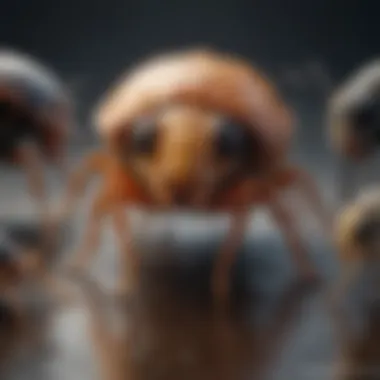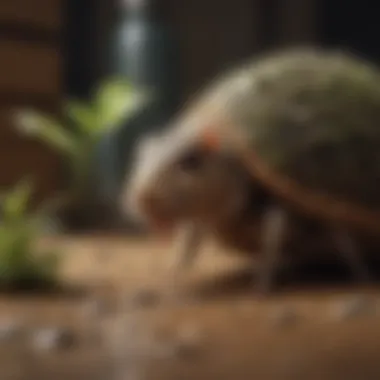Understanding HomeTeam Pest Defense Costs Explained


Intro
Understanding the costs associated with pest control services is crucial for homeowners and housewives alike. With numerous options available, especially in the realm of HomeTeam Pest Defense, it can become quite challenging to determine the best course of action. Every home is unique, and pest control costs can vary significantly based on several factors. This article aims to elucidate the intricate points impacting these costs, ranging from pest type to region and severity of the infestation. By offering a comprehensive overview, readers will be better equipped to manage their pest control budgets and make informed decisions.
Understanding Pests
Definition of Pests
Pests refer to organisms, such as insects or rodents, that cause harm to homes, gardens, or stored food. Common household pests include ants, roaches, termites, and rodents. Understanding what constitutes a pest is the first step toward effective management.
Importance of Pest Identification
Identifying a pest correctly is essential for determining the appropriate treatment. Mistaking one species for another can lead to ineffective pest control methods and unnecessary expenses. For example, different species of ants may require unique treatments and timing. Understanding the biology and behavior of pests helps to adopt a more targeted approach.
Prevention Techniques
Home and Garden Preventative Measures
Preventing infestations is often more cost-effective than treatment. Here are some effective strategies:
- Sealing Entry Points: Inspect your home for cracks and openings where pests can enter and seal them.
- Proper Food Storage: Keep food stored in airtight containers and immediately clean spills and crumbs.
- Maintaining a Clean Environment: Regularly discard garbage and clean up potential pest harborage sites.
- Regular Inspections: Periodically inspect both the inside and outside of your home for signs of pest activity.
Seasonal Prevention Tips
Different pest types emerge during various seasons. Understanding these patterns can prevent issues before they start. For example:
- Spring: Focus on preventing ants and termites by applying barriers and maintaining landscaping.
- Summer: Pay attention to wasps and mosquitoes by eliminating standing water around the property.
- Fall: Prepare for rodents looking for shelter by weather stripping doors and ensuring vents are covered.
Eco-Friendly Pest Control Solutions
Overview of Sustainable Practices
Increasingly, homeowners are turning to eco-friendly pest control options. These sustainable practices minimize harm to the environment, people, and pets. For instance, using traps instead of poisons allows for humane pest removal while reducing toxic chemical exposure.
Natural Remedies and Their Effectiveness
Many household items can act as effective pest deterrents. Common natural remedies include:
- Diatomaceous Earth: A non-toxic substance that can kill insects upon contact.
- Essential Oils: Peppermint oil, for example, can repel a variety of pests.
- Soap and Water: This simple mixture can effectively eliminate soft-bodied insects like aphids.
"Identification is key in effective pest management, leading to better resource allocation and cost-saving strategies."
By being informed and proactive, homeowners can mitigate pest issues before they escalate, ensuring they protect their investments and maintain a healthy living environment.
Preamble to HomeTeam Pest Defense
HomeTeam Pest Defense stands as a noteworthy service in the field of pest management. It addresses the pressing need for effective solutions in maintaining safe and healthy environments in our homes. The importance of pest defense cannot be overstated, as various pests can lead to significant damage, health risks, and financial strain.
Understanding the fundamentals of HomeTeam Pest Defense provides homeowners with a clearer perspective on their service offerings. This section will clarify what HomeTeam Pest Defense is and why engaging with such services is a prudent choice for many households.
What is HomeTeam Pest Defense?
HomeTeam Pest Defense is a professional pest control service dedicated to eliminating and preventing pest infestations in residential properties. Their range of services encompasses the treatment of common pests, such as ants, termites, and rodents, while also addressing less frequent invaders. Utilizing a blend of innovative techniques and traditional methods, HomeTeam aims to achieve effective results that align with the varying needs of each homeowner.
The company operates with a commitment to customer satisfaction. This includes comprehensive inspections, personalized treatment plans, and follow-up services to ensure pests do not return. Their approach emphasizes not just the elimination of pests, but also the importance of education and preventive measures—equipping homeowners with the knowledge to safeguard their properties effectively.
Why Consider Pest Defense Services?
Engaging with pest defense services, like those offered by HomeTeam, provides several advantages. First and foremost, it alleviates the stress associated with dealing with pests. An infestation is not just a nuisance; it can have serious implications for health and property values. Pests such as termites can lead to structural damage, while rodents can introduce diseases. Therefore, addressing these issues promptly is essential.


Moreover, professional pest control services are often more effective than DIY methods. Pest experts understand the behaviors and habitats of various pests, which is crucial for developing efficient treatment strategies. They bring professional-grade products and equipment that are simply not available to the average consumer, ensuring a higher level of effectiveness in pest elimination.
Additionally, recurring pest inspections offered by HomeTeam foster a proactive approach to pest management. Routine assessments help identify potential problems before they escalate into larger issues. By investing in pest defense services, homeowners can also potentially reduce long-term costs associated with extensive damages and health-related expenses.
"Prevention is better than cure" — this adage holds particularly true in the realm of pest control.
Through a structured and informed approach, HomeTeam Pest Defense provides the necessary solutions to protect homes and ensure peace of mind.
Factors Influencing Pest Defense Costs
Understanding the factors that influence pest defense costs is critical for homeowners considering pest management options. These elements can significantly alter the overall cost of services and can lead to unexpected expenses if not properly assessed. Knowing how type of pest, severity of infestation, size of property, and location and accessibility impact pricing allows homeowners to make informed and strategic decisions regarding their pest control needs.
Type of Pest
The type of pest involved in an infestation plays a crucial role in determining treatment costs. Different pests present varying degrees of risk, and their treatment may necessitate distinct approaches and products. For instance, common household pests such as ants, roaches, or spiders may incur lower costs due to the standard treatment methods employed. Conversely, tackling more specialized or harmful pests like termites or bedbugs often requires more advanced techniques and materials, leading to increased costs. Understanding the specific pest challenges one faces helps homeowners prepare for the financial commitment involved in effective pest control.
Severity of Infestation
The severity of an infestation significantly affects both the cost and the complexity of pest control services. A mild issue that can be addressed with routine services may cost less than a severe infestation requiring extensive treatments and specialized services. For example, if a termite problem is detected early, treatment might just involve localized applications. However, a more widespread infestation might demand structural repairs, fumigation, or more aggressive strategies that escalate costs. Homeowners should assess the urgency of pest issues and consider the long-term implications of ignoring a severe infestation.
Size of Property
The size of the property directly correlates with pest control costs. Larger homes or properties require more time for inspection and treatment, which can raise the overall bill. Pest control companies often calculate their prices based on the square footage of the premises. Consequently, a sprawling estate may need a tailored approach with customized services. Additionally, the challenge of accessing hard-to-reach areas or additional structures like sheds can contribute to increased costs. Understanding how property size influences pricing is beneficial for those looking to budget effectively for pest defense services.
Location and Accessibility
The location of a property also plays a vital role in pest control costs. Urban areas might see different pricing structures compared to rural regions due to varying competition and demand for services. Accessibility may also factor in, as difficult-to-reach locations can require more labor-hours and specialized equipment, thus increasing the overall cost. Homeowners should consider both regional pricing variations and their specific property’s accessibility when seeking pest management solutions.
Understanding these factors empowers homeowners to anticipate expenses and make informed decisions about pest prevention and control.
When evaluating pest defense costs, it is essential to account for the interplay between these various elements. Acknowledging how each aspect contributes to the overall expenses allows homeowners to better navigate their pest control options.
Types of Services Offered by HomeTeam
Understanding the spectrum of services provided by HomeTeam Pest Defense is crucial for homeowners seeking effective pest management solutions. Each service is tailored to meet specific needs and infestations, ensuring the right approach is taken for maximum efficacy.
General Pest Control Services
General pest control services form the backbone of HomeTeam's offerings. These services typically address common household pests such as ants, flies, cockroaches, and spiders. Employing a proactive stance, these services aim to establish a pest-free environment through inspections, treatments, and follow-up visits.
HomeTeam's approach includes initial assessments to identify potential entry points and breeding grounds of pests. Treatment may involve a combination of chemical and non-chemical methods. This dual approach allows for effective elimination while minimizing the impact on human health and the environment. Additionally, ongoing monitoring ensures that infestations do not recur, enhancing long-term peace of mind for homeowners.
Specialized Treatments
Not all pest problems are the same. HomeTeam offers specialized treatments to address tougher infestations, such as bed bugs, termites, and rodents. The nature of these pests demands targeted strategies that can include bait systems or heat treatments.
For instance, termite treatments often involve comprehensive inspections that determine the extent of the infestation. HomeTeam may use liquid barriers or baiting systems, methods designed for long-term control. Bed bug treatments usually combine vacuuming and heat treatment, focusing on eliminating both adult insects and eggs. Each specialized service reflects an understanding of the unique biology and behavior of these challenging pests.
Preventive Measures
Preventive measures are an integral aspect of pest management. HomeTeam recognizes that it is often more efficient and cost-effective to prevent pest issues before they arise. This involves routine inspections and treatments aimed at deterring pests.
Services in this category may include sealing entry points, removing conducive conditions for pests, and providing education on maintaining a pest-resistant home. By implementing preventive strategies, homeowners can save money in the long run and ensure a healthier living environment.
Preventive measures not only reduce the likelihood of pest infestations but also can significantly lower long-term costs associated with pest control.
In summary, the variety of services offered by HomeTeam Pest Defense caters to the distinct needs of homeowners. From general pest control to specialized treatments and preventive measures, each service aims to provide effective solutions that ensure a comfortable, pest-free home.
Cost Breakdown of HomeTeam Services
The Cost Breakdown of HomeTeam Services is a crucial topic in understanding how pest control expenses are calculated. Knowing the costs involved helps homeowners budget effectively, allowing them to make informed choices about pest management. By dissecting fees based on various services, it enables clarity on what to expect when seeking pest defense solutions.


Understanding each component of the cost structure not only reveals the logic behind pricing but also aids in evaluating the overall value of services. HomeTeam emphasizes transparency, ensuring clients comprehend what they are paying for.
Initial Inspection Costs
Initial inspection costs typically start the conversation around pest management expenses. This fee covers the professional assessment of one’s property to identify pest issues. The importance of this initial step cannot be overstated. It serves as the foundation for any required treatments, providing valuable insights about the type and extent of the infestation.
Many companies, including HomeTeam, offer free or low-cost inspections to encourage potential clients to seek help. However, it's essential to confirm what the inspection entails. A comprehensive evaluation should cover all affected areas, detailing the species involved and recommending a tailored approach for treatment.
Many homeowners may also overlook the significance of this step. Understanding initial costs helps in making budgetary decisions without unexpected surprises later on. Nonetheless, it is wise to consider that the accuracy and thoroughness of the inspection can significantly influence future treatment costs.
Treatment Costs
Treatment costs represent the core of any pest control service fee structure. Once pest issues are identified, this phase encompasses the actual application of measures to eliminate or control those pests. These costs vary broadly, influenced by factors such as type of pest, severity of infestation, and physical property size.
For example, treating a minor ant problem typically incurs a much lower cost compared to addressing widespread termite damage. HomeTeam offers a variety of treatment options, which can range from standard spray treatments to specialized treatments for specific pest types. Understanding these costs provides homeowners the opportunity to choose the most suitable option for their needs and budget.
Furthermore, clients must consider the possibility of multiple treatments. Some infestations may require follow-up applications to ensure effectiveness. Therefore, budgeting for potential additional treatments becomes essential in managing overall costs effectively.
Ongoing Maintenance Plans
Considering ongoing maintenance plans is vital for sustained pest control after initial treatments. HomeTeam, like many pest defense services, offers such plans that usually include regular inspections and treatments over a set period, potentially yielding cost savings in the long run.
These plans often cost more upfront; however, they can prevent larger infestations, ultimately saving money on future treatments. Regular maintenance is especially beneficial in regions where pests are prevalent. Homeowners must evaluate the long-term benefits against the ongoing costs to make a sound financial decision.
By committing to an ongoing maintenance plan, clients can often receive priority service, customized pest management strategies, and peace of mind knowing their home is continuously monitored.
Regional Variations in Pest Defense Costs
Understanding regional variations in pest defense costs is crucial for homeowners. These variations can significantly affect overall expenses and choices. Furthermore, regional pricing is influenced by population densities, local regulations, and pest prevalence. As such, awareness of these factors can help homeowners budget effectively and make informed decisions about pest management.
Urban vs Rural Pricing
Urban areas typically face higher pest control costs compared to rural regions. This price difference often stems from two main reasons: density of housing and cost of living. In cities, the concentration of homes makes it easier for pests to thrive, thus necessitating more frequent treatments.
Moreover, service providers often charge more due to travel costs and logistical challenges in densely populated areas. On the other hand, rural homeowners might experience lower pricing. Fewer homes means a less critical need for constant pest control. Furthermore, travel time for pest control technicians to rural locations may be longer, impacting service availability.
State-Specific Trends
Beyond urban and rural distinctions, costs also vary significantly by state. For example, states prone to specific pests, such as termites in Florida or rodents in New York, may see higher service rates. In states like California, the varied climate contributes to diverse pest populations, prompting specialized treatments that may raise costs.
Additionally, local regulations can influence prices. Some states may mandate specific certifications or environmentally-friendly pest control methods, affecting the overall service costs. It's essential for homeowners to research local tendencies and trends to accurately gauge what they might expect in terms of pricing.
"Regional factors can lead to substantial differences in pricing, impacting your selection of pest control services."
By understanding these regional dynamics, homeowners can better navigate the complexities of pest defense pricing and select services that suit both their needs and budgets.
Evaluating Cost-Effectiveness
Evaluating cost-effectiveness is essential in the context of pest management services. This section will explore why understanding the financial implications of various pest control options is critical. Homeowners often face the dilemma of whether to invest in professional services or opt for do-it-yourself solutions. Evaluating cost-effectiveness involves assessing not only the price of treatments but also their potential benefits and long-term savings.
A thorough evaluation means looking beyond initial costs. It includes short-term and long-term expenses, pest prevention, and potential health risks which can stem from unchecked pest infestations.
Short-Term vs Long-Term Expenses
When considering pest control, one must differentiate between short-term and long-term expenses. Short-term costs are typically the immediate expenses incurred during treatment. This could include the cost of inspection, initial treatments, and any follow-up visits needed to address pest issues. In contrast, long-term expenses encompass ongoing maintenance plans, replacement of damaged property, and potential health-related costs associated with pest presence.
Investing in professional pest control services may seem expensive at first. However, it is vital to consider how these expenses can pay off over time. For example, if a severe pest infestation is treated properly, homeowners may save on repairs and damages that pests would otherwise cause.
- Short-Term Costs:
- Long-Term Costs:


- Initial inspection fees
- Treatment price
- Follow-up service charges
- Maintenance plans
- Property repairs
- Health costs related to infestations
A well-strategized plan will often lead to significant savings, making an initial investment in pest defense seem reasonable when viewed through the lens of long-term benefits.
Potential Health Risks and Costs
Ignoring pest problems can have serious health implications. Pests like cockroaches, rodents, and termites are not just nuisances; they pose tangible health risks. These risks can lead to costly healthcare expenses down the line. For instance, a minor infestation could escalate, leading to respiratory issues or allergic reactions.
Investing in pest defense services like HomeTeam Pest Defense can mitigate these risks. By addressing infestations swiftly, homeowners can avoid potential consequences that come from pest-induced health problems. This preventive approach often reduces long-term medical costs associated with pest-related illnesses.
"Preventing infestations is not just about comfort; it's about health and safety. Deciding to control these pests effectively can prevent unforeseen medical expenses."
Additionally, a thorough evaluation of potential health risks and their associated costs is necessary. Not addressing a pest issue could also lead to loss of property value. Homes that are known for pest problems may face declining interest in the market, impacting the homeowner’s financial future. Thus, evaluating cost-effectiveness encompasses immediate and distant impacts on both finances and health, helping homeowners to make informed decisions in pest management.
Alternatives to HomeTeam Pest Defense
When addressing pest control needs, it is crucial to consider all available options beyond the services provided by HomeTeam Pest Defense. Exploring these alternatives helps homeowners understand what works best for their circumstances, budget, and specific pest management requirements. The potential alternatives range from do-it-yourself (DIY) solutions to hiring other professional services. Each option has its own set of benefits and considerations.
DIY Pest Control Solutions
DIY pest control offers a more hands-on approach for those looking to manage pest issues independently. There are several advantages to pursuing this path:
- Cost Savings: Homeowners can often save money by using over-the-counter products or natural remedies instead of hiring professionals for treatment.
- Immediate Action: DIY solutions allow for rapid response to pest sightings without the waiting time often involved in scheduling professional services.
- Customization: Homeowners can tailor their approach based on specific infestations, using products that best suit their needs.
However, DIY methods come with drawbacks. Misuse of products can lead to ineffective treatments or even safety hazards, especially for households with children or pets. Homeowners must also be cautious and ensure they identify the pest correctly to choose the right treatment. It's important to note that in more severe infestations, DIY may not be sufficient, necessitating professional intervention.
Common DIY Methods
- Natural Repellents: Many common household items, like vinegar or essential oils, can deter certain pests.
- Traps: Sticky traps or bait stations can effectively monitor and control rodent populations.
- Insecticidal Sprays: Over-the-counter insecticides are available for general pest control, though they should be used according to the instructions carefully.
Other Professional Services
For those who may find DIY methods unsuitable or ineffective, there are various other professional pest control services available in addition to HomeTeam Pest Defense. Considering these services can provide valuable insights into pest management strategies and cost structures:
- Local Pest Control Companies: Often, smaller, local companies can provide competitive pricing and personalized service tailored to the community's needs.
- Specialized Pest Control Services: Some companies focus on specific pests, such as termites or bed bugs, offering in-depth expertise in their treatment.
- Integrated Pest Management (IPM) Services: These services emphasize long-term pest control through environmentally sound practices and strategies designed to minimize chemical use.
While exploring these options, it is essential to evaluate certifications and customer reviews to ensure quality service. Choosing professionals with good reputations can lead to effective pest elimination while enhancing value for money.
"Understanding various pest control options helps homeowners make informed choices tailored to their specific needs."
In summary, considering alternatives to HomeTeam Pest Defense can empower homeowners to select the best pest management solutions tailored to their specific situations, balancing both efficacy and budget concerns.
Ending
The conclusion of the article serves as a vital point of reflection regarding the costs associated with HomeTeam Pest Defense services. Understanding these costs is not merely about numbers; it involves comprehending a broader context that integrates service quality, effectiveness, and ongoing support. For homeowners and housewives alike, recognizing the significance of making informed decisions can lead to more efficient pest management practices.
Making Informed Choices
Making informed choices in pest control is essential. Homeowners should assess various elements such as the type of pest, severity of infestation, and region-specific factors before committing to a pest defense plan. A thorough understanding of the service offerings provided by HomeTeam is crucial in selecting the right solution for one's particular needs.
Factors to consider include:
- Initial Costs: What will be required for the first pest inspection or treatment?
- Ongoing Maintenance: How much will regular services cost over time?
- Effectiveness: Are the treatments long-lasting? Will they genuinely resolve the pest problem?
- Health Risks: What potential health hazards do pests pose?
By weighing these factors, homeowners can make decisions that optimize both financial and health benefits.
Final Thoughts on Cost Management
Cost management in pest control does not only rely on the ability to pay for services upfront. It involves thinking long-term about potential expenses and saving opportunities. Evaluating options, such as DIY pest control versus professional services, allows for smarter budgeting. Although DIY methods may appear cheaper initially, they might lead to higher costs later due to ineffective treatment.
Instead, taking the time to analyze the value of professional services like those offered by HomeTeam is essential. This can prevent future infestations, reducing long-term costs and ensuring a healthier living environment.
In summary, understanding and managing the costs associated with HomeTeam Pest Defense requires a careful approach, focusing on informed choices and cost-effective strategies. Through this, homeowners can safeguard their properties and investment effectively.



